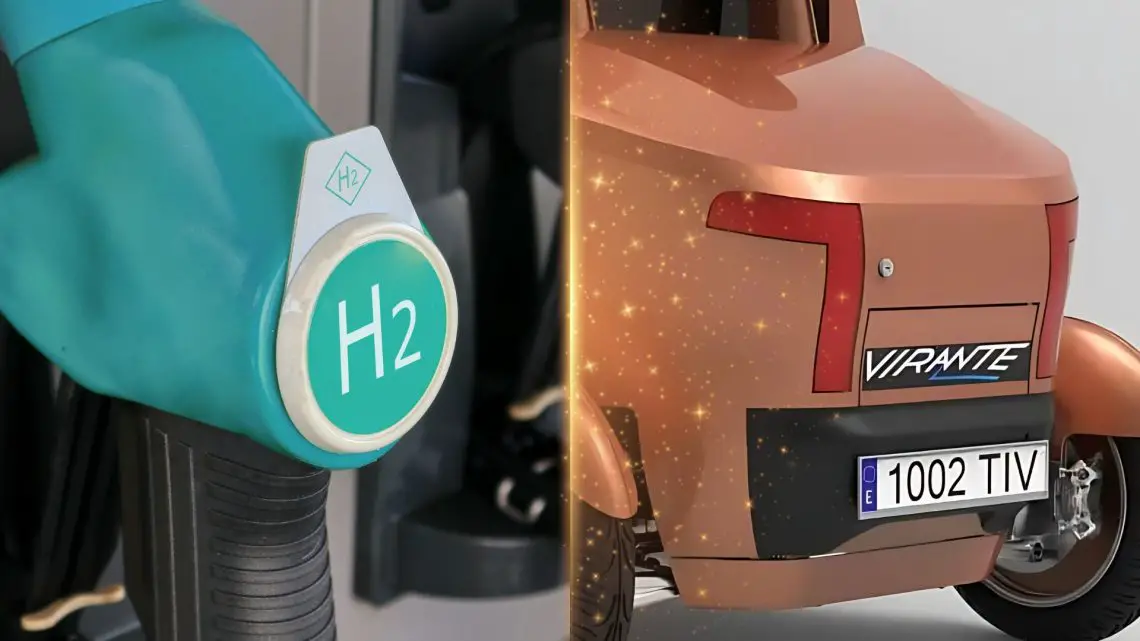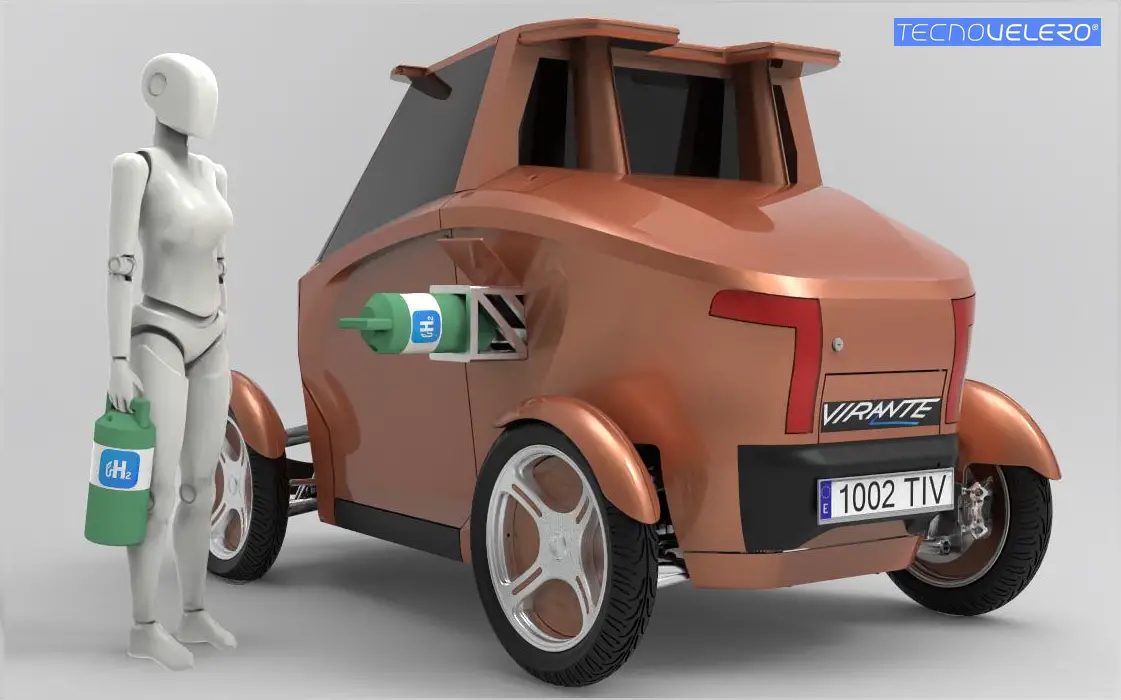
The Hydrogen Car That Swaps, Stabilizes, and Simplifies – Meet the Virante
December 10, 2024Revolutionizing Hydrogen Vehicles with Swappable Hydrogen Cartridges
Hydrogen-powered vehicles have long been recognized as a sustainable alternative to fossil fuel cars. Yet, their adoption has been hindered by the complexity and cost of recharging infrastructure. Tecnovelero SL, a Spanish startup specializing in innovative urban mobility solutions, is redefining this narrative with its flagship product, the Virante car. What sets this hydrogen-powered electric vehicle (FCEV) apart is its groundbreaking Hydrogen Swapping System (H2SW). This system bypasses the need for high-pressure hydrogen refueling stations, which require costly, time-intensive infrastructure, by introducing swappable hydrogen cartridges.
The H2SW system relies on a low-pressure hydrogen tank design that drivers can replace in seconds. This process eliminates the prolonged wait times associated with traditional hydrogen refueling while significantly lowering the infrastructure investment typically required for hydrogen mobility. Its simplicity makes the Virante car an ideal solution for urban environments and densely populated areas where efficiency is paramount.
With a driving range of over 400 kilometers, the Virante car offers both practicality and sustainability. Its accessibility makes it a competitive choice for car-sharing platforms and fleet services, demonstrating Tecnovelero’s dedication to transforming urban mobility into a seamless, eco-friendly experience.

Image Credit Tecnovelero
Summing It Up: Hydrogen Swapping System (H2SW)
-
Addressing Refueling Challenges
- Overcomes traditional hydrogen vehicles’ reliance on time-intensive high-pressure refueling stations.
- Offers a modular, low-pressure hydrogen cartridge system for quick and seamless swapping.
-
Effortless Operation
- Replacing hydrogen cartridges takes just seconds, similar to refilling a gas tank.
- Designed for simplicity, enabling use by fleet operators and individual drivers alike.
-
Enhanced Safety and Accessibility
- Low-pressure design significantly reduces risks compared to high-pressure systems.
- Eliminates the need for expensive infrastructure, making it perfect for urban and developing areas.
-
Cost-Effective and Scalable
- Can integrate with existing logistical networks like fleet depots or retail hubs.
- Supports broader adoption of hydrogen mobility by reducing the investment needed for infrastructure.
Tilting Variable Technology (eTIV)
-
Unmatched Stability and Control
- Dynamically adjusts the car’s tilt during turns, enhancing grip and reducing lateral forces.
- Ensures stability even on sharp bends or uneven terrain, significantly improving safety.
-
Advanced Sensors and Actuators
- Real-time monitoring of variables such as speed, road conditions, and turning angles.
- Micro-adjustments optimize the vehicle’s balance to reduce rollover risks and improve handling.
-
Energy-Efficient Design
- Reduces friction and optimizes load distribution for smoother, more efficient rides.
- Enhances vehicle performance, making it ideal for urban transportation.
-
User-Focused Innovation
- Improves driver confidence, especially important in hectic city environments.
- Designed to enhance both safety and comfort, addressing key concerns of urban drivers.
Rigorous Real-World Testing
-
Stress Testing for Cartridge Durability
- Hydrogen cartridges were subjected to varying temperatures, pressures, and vibrations.
- Ensured long-term performance and safety in demanding urban conditions.
-
Performance Validation in Urban Environments
- eTIV technology tested under conditions like sudden lane changes, stop-and-go traffic, and sharp turns.
- Proven to improve responsiveness, stability, and ride comfort during real-world usage.
Tilting Variable Technology (eTIV): Redefining Vehicle Stability
Beyond its fueling innovation, the Virante car integrates Tecnovelero’s patented Tilting Variable Technology (eTIV). This advanced system enhances vehicle stability by dynamically adjusting the car’s tilt during turns, ensuring a safer and smoother ride. Real-time sensors monitor factors like road conditions and turning angles, and the system actively stabilizes the vehicle to reduce risks such as rollovers or loss of control.
eTIV technology is especially beneficial in urban settings with stop-and-go traffic and sharp corners. By improving overall handling and ride comfort, it elevates the urban driving experience, addressing not just functionality but emotional ease for drivers and passengers alike. Additionally, its energy-efficient design optimizes load distribution, contributing to the vehicle’s performance and sustainability.
Cutting-Edge Technology Tested for Real-World Conditions
Tecnovelero’s commitment to real-world applicability is evident in its rigorous testing of the H2SW system and eTIV. The hydrogen cartridges were evaluated under variable conditions, including extreme temperatures and vibrations, to ensure durability and reliability in urban operation. Similarly, eTIV was tested in high-demand scenarios such as sudden lane changes and heavy traffic, proving its capability to stabilize and enhance vehicle performance amidst everyday challenges.
Comparing Virante to Traditional Hydrogen EVs
Traditional hydrogen-powered vehicles depend on high-pressure refueling infrastructure, which imposes significant setup costs and safety requirements. Tecnovelero’s low-pressure H2SW system addresses these issues by offering a safer and more adaptable alternative. Designed to integrate into existing logistical networks such as retail hubs and fleet depots, the system reduces operational barriers to widespread hydrogen adoption.
The Virante car’s innovations make it not only cost-effective but safer for city use. Unlike high-pressure systems, its low-pressure cartridges mitigate safety risks, simplifying installation, maintenance, and usage. Combined with the eTIV technology for enhanced control and stability, the Virante car emerges as an accessible, reliable, and future-ready solution for urban mobility.
From 36,000 Hours of R&D to Industry Accolades
Tecnovelero’s achievements are the product of extensive research and development, with over 36,000 hours dedicated to perfecting the Virante car. By focusing on both innovation and practical deployment, the company has developed a product that caters to the evolving demands of urban transportation. This R&D effort has earned Tecnovelero reputable accolades, including being named an “Innovation SME” and securing the Best Startup Chamber of Tarragona Award.
Expanding into the Asia-Pacific Market
Tecnovelero’s international ambitions include tapping into the Asia-Pacific market, a region well-suited for hydrogen-powered innovation. Markets like China, Korea, and Japan are leaders in hydrogen adoption and EV technologies, providing a fertile ground for the Virante car. Localized partnerships and collaborations are at the core of Tecnovelero’s strategy, enabling job creation in high-demand areas such as vehicle assembly and logistics. Plans for localized production aim to stimulate industrial growth while meeting the needs of metropolitan areas grappling with pollution and congestion.
Benchmarking data from Spain’s Ministry of Exportations (ICEX) has identified a production potential of 200,000 units annually, representing a $2.4 billion market opportunity in Asia-Pacific. Such projections reinforce Tecnovelero’s focus on scaling production while remaining innovation-driven.
The Future of Urban Mobility
Tecnovelero’s Virante car, with its revolutionary Hydrogen Swapping System and eTIV technology, addresses critical pain points in hydrogen mobility. By simplifying refueling and enhancing safety, it offers a practical yet innovative solution for modern urban challenges. With plans to expand globally and a showcase at COMEUP Stars 2024, Tecnovelero is poised to reshape the future of sustainable urban transport.
By eliminating lengthy recharge times, enhancing safety, and ensuring cost-effective scaling, Tecnovelero’s Virante car embodies the promise of cleaner, more efficient urban mobility. Fueled by a steadfast commitment to innovation, it paves the way for a greener, smarter transportation network.



 With over 15 years of reporting hydrogen news, we are your premier source for the latest updates and insights in hydrogen and renewable energy.
With over 15 years of reporting hydrogen news, we are your premier source for the latest updates and insights in hydrogen and renewable energy.
Is the Virante a fuel cell or converted ICE platform?
Always thought ICE engines using H2 would make an easier change from gas and even better if low pressure H2 will work. Less complicated & familiar technology.
Dear Ken, you are right, it is probably the most user-friendly and viable mobility of the future.
The Virante is a low-pressure H2 fuel cell vehicle, with the following characteristics:
450Kg
16kW peak power
0.70 H2 Kg 400Km autonomy/0.7kg=571/L=1343 MPG
90kM/H=56mph
If you need more information, please contact us at info@tecnovelero. com
Regards.